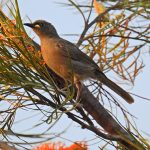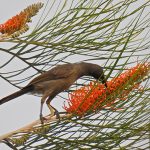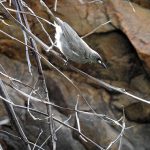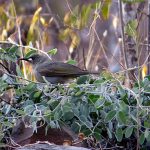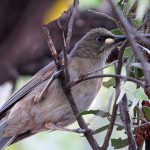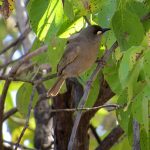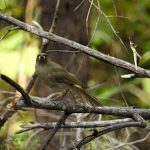WHITE-GAPED HONEYEATER
The White-gaped Honeyeater is a medium-sized bird, measuring about 20 centimetres in length. Despite its small size, the White-gaped Honeyeater is a fierce defender of its territory, often chasing away larger birds that encroach on its domain. Its plumage is predominantly olive-brown, blending seamlessly with the foliage of its habitat. The most striking feature, as its name suggests, is the distinctive white gape—a line at the base of its beak. This feature stands out against its darker face and is a key identifier. The bird is also adorned with a subtle yellow wash on its wings and tail, adding a touch of vibrancy to its appearance.
This honeyeater calls the tropical and subtropical regions of northern Australia home. It thrives in open woodlands, mangroves, and along watercourses, where the lush vegetation provides ample resources for its survival
The White-gaped Honeyeater is a vocal bird, contributing to the symphony of the bush with its melodious calls. Its song is a series of clear, ringing notes, often delivered in a repetitive sequence that resonates through the trees. These calls serve as a means of communication, marking territory and attracting mates.
True to its name, the White-gaped Honeyeater feeds primarily on nectar, which it skillfully extracts from flowers using its specialised brush-tipped tongue. It plays a vital role in pollination, as it transfers pollen from flower to flower while feeding on nectar. However, it is not solely reliant on nectar; it supplements its diet with insects and spiders, providing a balanced intake of nutrients.
The breeding season for these honeyeaters typically aligns with the wet season, from October to March, when food is abundant. They are known to be monogamous, forming pair bonds that last through the breeding period.
Their nests are delicate and well-crafted structures, often suspended in the fork of a tree branch. Made from grasses, bark, and spider webs, the nests are beautifully camouflaged against predators. The female usually lays two to three eggs, which are incubated for about two weeks before hatching.
While specific data on the longevity of the White-gaped Honeyeater is limited, many honeyeaters can live for several years in the wild, depending on environmental conditions and predation pressures.
As for conservation status, the White-gaped Honeyeater is currently listed as Least Concern, indicating that it is not at immediate risk of population decline. However, habitat preservation remains crucial to ensure its continued survival.
In the grand tapestry of Australia’s wildlife, the White-gaped Honeyeater is a testament to the beauty and complexity of nature. Through its melodious calls and vital ecological role, it continues to enchant those who venture into its habitat, reminding us of the delicate balance that sustains our natural world.

